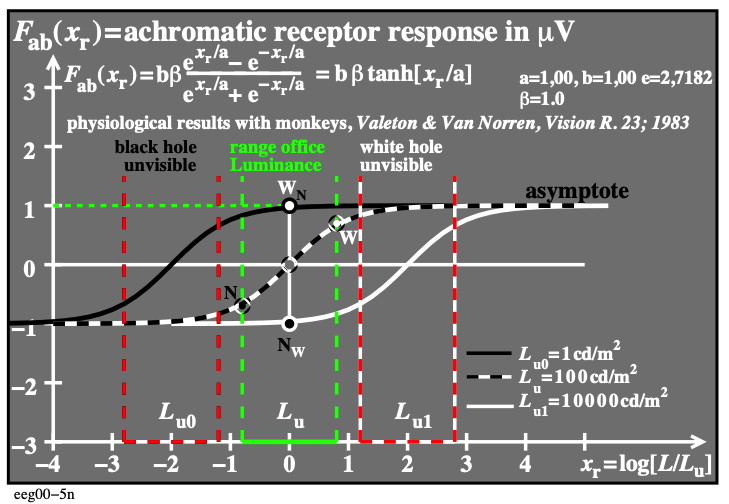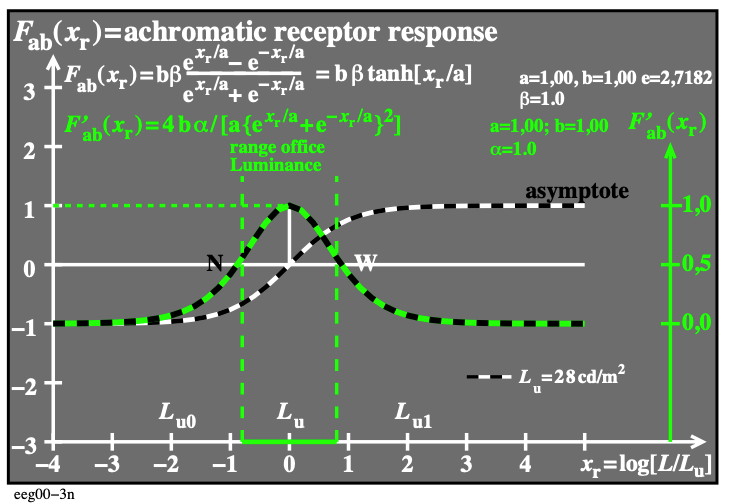231001 'HAND' http://farbe.li.tu-berlin.de/eea_s43.htm or
http://color.li.tu-berlin.de/eea_s43.htm.
Project title: Colour and colour vision with Ostwald, device, and elementary colours -
Antagonistic colour-vision models TUBJND and TUBLAB, and properties for many applications
Chapter E: Colour Metrics, Differences, and Appearance (2023),
Main part eea_s, under work
Titles and links to six different topics (all under work in 2023)
Title of part 4.1: Achromatic colour metric for the surface colour range for adjacent (a) and separated (s) samples
eea_s41 in English or
ega_s41 in German.
Title of part 4.2: Achromatic and chromatic colour metric for the surface colour range
eea_s42 in English or
ega_s42 in German.
Title of part 4.3: Achromatic colour metric for a wide luminance range between the
Low, Standard and High Dynamic Range (LDR, SDR, and HDR)
eea_s43 in English or
ega_s43 in German.
Title of part 4.4: Achromatic and chromatic colour metric for a wide luminance range between the Low, Standard and High Dynamic Range (LDR, SDR, and HDR)
eea_s44 in English or
ega_s44 in German.
Title of part 4.5: Research results and connections of special CIE and TUB colourimetries
eea_s45 in English or
ega_s45 in German.
Title of part 4.6: Research results on the colour appearance attribute colourfullness
eea_s46 in English or
ega_s46 in German.
For links to the main chapter E
Colour Metrics, Differences, and Appearance (2023),
under work.
Content list of chapter E (links and file names use small letters), see
eea_s in English or
ega_s in German.
_________________________
Title of part 4.3: Achromatic colour metric for a wide luminance range between the Low, Standard
and High Dynamic Range (LDR, SDR, and HDR)
4.31. Introduction.
New displays of the High Dynamic Range (HDR) may lead to new possibilities for the ergonomic display output compared to the Standard Dynamic Range (SDR). The ergonomic output according to ISO 9241-306 on displays with the HDR range compared to the SDR range is a topic of standardisation, see for example
ISO/TS 22028-5:2023 Photography and graphic technology - Extended colour encodings for digital image storage, manipulation and interchange - Part 5: High dynamic range and wide colour gamut encoding for still images (HDR/WCG)
ISO 9241-306:2018 Ergonomics of human-system interaction - Part 306: Field assessment methods for electronic visual displays
defines the SDR luminance range LW : LN = 36 : 1 for output on paper and on displays.
For the black N, the Grey U, and the White W the following standard values are given:
black N: LN=3,3 cd/m^2, YN=2,5 = YU/7,2
grey U: LU=24 cd/m^2, YU=18
white W: LW=142 cd/m^2, YW=90 = 5 YU
The luminance contrast ratio is therefore C = LW : LN = YW : YN = 90:2,5 = 36:1.
In applications especially the values for black differ, the values may be
YN=1,8 = YU/10 for high glossy photographic paper,
YN=2,5 = YU/7,2 for semi glossy offset paper,
YN=3,6 = YU/5 for matte office paper.
In analog and digital photography instead of the contrast range
YW : YN = 90:2,5 = 36:1
luminance-contrast ranges between
LW : LN = 1000:1 (4 log units) and 1000000:1 (6 log inits) are possible.
An achromatic colours metric for the applications LDR, SDR, and HDR will be developed in this part 4.3.
A chromatic colours metric for the applications LDR, SDR, and HDR will be developed in part 4.
4.32: Deductive and inductive methods to match the connections between physiological and psychophysical experimental data
The deductive TUB-colorimetry starts with physiological data, for example of Valeton and Van Norren (1973), which are approximated here by the function tanh(x) (tangens hyperbolicus), see Fig. 4.34-1.

Fig. 4.32-1: Physiological response function (S-shaped) for three surround luminance as function of log (L/Lu)
For the download of this figure in the VG-PDF format, see
eeg00-5n.pdf.
All response functions Fab have are S-shaped and are similar. The derivation F'ab of one response function is Gauss-shaped, see Fig. 4.32-2.

Fig. 4.32-2: Response function (S-shaped) and derivation function (Gauss shaped) as function of log (L/Lu)
For the download of this figure in the VG-PDF format, see
eeg00-3n.pdf.
The inductive TUB-colorimetry starts with psychophysical data, for example
of Lingelbach and Haberich (1977), which are approximated by Richter (1993),
see Fig. 4.32-3.

Fig. 4.32-3: Luminance threshold dL as function of L and Lu
For the download of this figure in the VG-PDF format, see
een40-1a.pdf.
The ratio L/dL is called the contrast sensitivity, see Fig. 4.32-4.

Fig. 4.32-4: Contrast sensitivity L/dL as function of L and Lu
For the download of this figure in the VG-PDF format, see
een40-2a.pdf.
All contrast functions in Fig. 4.32-4 are similar compared to F'ab in Fig. 4.32-2. Therefore there is agreement between the deductive and the inductive contrast L/dL as function of L and Lu.
Therefore the physiological and psychophysical contrast functions agree to a high degree. There is an explanation of important remaining differences of the physiological and the psychophysical contrast calculation.
Only for high luminance levels near 300 cd/m^2 the maximum contrast is at the luminance Lu of the surround. This is in agreement with the physiological (1993) data. The symmetry of the physiological contrast disappears in the psychophysical data. However, for very short viewing times (<0,1s) of the two adjacent stimuli the psychophysical contrast is symmetric. Therefore there is wide agreement between the deductive and inductive contrast as function of L and Lu.
4.33. Extention of the luminance range of surface colours in offices to a wide luminance range used in High Dynamic Range (HDR) applications.
text
4.34: Main coordinates relative lightness L*/L*u and relative contrast (L/dL)/(L/dL)u.
text
4.35. Physiological and psychophysical relative lightness L*/L*u and relative contrast (L/dL)/(L/dL)u.
text
_________________________
For links to the main chapter E
Colour Metrics, Differences, and Appearance (2023),
under work.
Content list of chapter E (links and file names use small letters), see
eea_s in English or
ega_s in German.
This web page is since 2023 under work.
In future the figures and the text may be improved.
Link to the next topic (under work in 2023)
Title of part 4.4: Chromatic colour metric for a wide luminance range between the Low, Standard and High Dynamic Range (LDR, SDR, and HDR)
eea_s44 in English or
ega_s44 in German.
-------
For the TUB start site (not archive), see
index.html in English, or
indexDE.html in German.
For the TUB archive site (2000-2009) of the BAM server
"www.ps.bam.de" (2000-2018)
about colour test charts, colorimetric calculations, standards,
and publications, see
indexAE.html in English,
indexAG.html in German.
For similar Information of the BAM server "www.ps.bam.de"
from the WBM server (WayBackMachine)
https://web.archive.org/web/20090402212108/http://www.ps.bam.de/index.html



